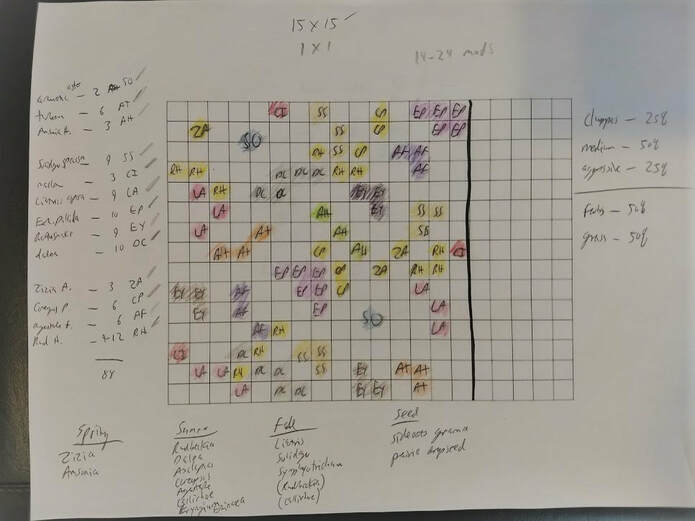Aromatic Aster (Symphyotrichum oblongifolium) SO
Butterfly Weed (Asclepias tuberosa) AT
Bluestar (Amsonia hubrichtii) AH
Showy Goldenrod (Solidago speciosa) SS
Purple Poppy Mallow (Callirhoe involucrata) CI
Rough Blazingstar (Liatris aspera) LA
Pale Coneflower (Echinacea pallida) EP
Rattlesnake Master (Eryngium yuccifolium) EY
White Prairie Clover (Dalea candida) DC
Golden Alexanders (Zizia aurea) ZA
Prairie Coreopsis (Coreopsis palmata) CP
Blue Hyssop (Agastache foeniculum) AF
Black-Eyed Susan (Rudbeckia hirta) RH
On the bottom are seasonal bloom lists, and on the right some percentages I was trying to work out. The latter is key and site specific; since I anticipate weed competition on a dry slope, our goal is to cover the site quickly with plants and seed, then to manage for weeds the first year when their pressure will be the greatest. Some of the plants are aggressive spreaders, by runners or seeding, while others are behaved clumpers. I'm trying to find the right balance between clumpers and spreaders -- the former will give us more formal definition, appealing to a traditional expectation of what a garden looks like (think anchor or architectural plants), and the latter will help us replace mulch while providing seasonal color. How the roots compete with and support surrounding plants was also part of the thinking. I'm still playing around and have several iterations of the grid.
You could take this plan and make a 15x15 foot garden. Or you could treat it as a test plot for future expansion, repeating the plan in the years ahead around the initial plot. The key here is lots of plants. Under and around the forbs will be sown 1-2 short grasses (sideoats grama, prairie dropseed, etc), which in a year will fill in creating the matrix, base layer, or groundcover which will replace the need for wood mulch. The plant density -- on one foot centers or less -- will provide multiple environmental benefits: competing against weeds above and below the soil line, providing pollinator habitat year round, amending soil, slowing runoff, and providing seasonal color for us to enjoy. What do you think?



 RSS Feed
RSS Feed

